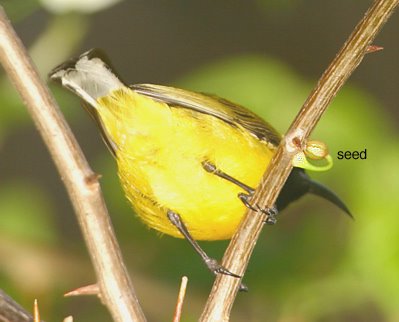Nearly every evening in early January, from about 6.00 pm, a pair of male Olive-backed Sunbirds (Nectarinia jugularis) (top) would settle down on my neighbour’s bougainvillea bush and spend some free time preening. In between preening they would simply sit tight, stretch their wings and enjoy the scenery. At exactly 7 pm when it was still light, they would suddenly fly off, where to, I do not know. Some days there would only be one bird.
On other days there would also be a pair of lovey-dovey Oriental White-eye (Zosterops palpebrosus) (bottom). I presume this was a pair, as the two birds would often sit close together, sometimes indulging in allopreening.
The Crimson Sunbird (Aethopyga siparaja) sometimes visit the bush but stayed only for a short while, never resting on a branch for more then a few seconds. They are the ones regularly visiting my noni tree (Morinda citrifolia).
These birds, together with Scarlet-backed Flowerpecker (Dicaeum cruentatum) and Brown-throated Sunbird (Anthreptes malacensis) were always around the mistletoe Macrosolen cochinchinensis when this plant was flowering and fruiting. This semi-parasitic plant grows on the branches of a nearby mempat tree (Cratoxylum formosum) that, thankfully have been left alone and not pruned away by the maintenance crew of the National Parks Board. When the mistletoe plants were flowering and fruiting, these birds enjoyed the copious nectar secreted by the flowers and the succulent berry-like fruits.
Being a regular perching bush of these birds that feed on the mistletoes, the bougainvillea obviously shows signs of the presence of their germinating seeds. These can clearly be seen growing on the stems of the bush (see germinating seed, above), no doubt in time to come, will weaken the flowering bush unless they are removed.
YC Wee
Singapore
26th February 2006
PS: About a month after the above piece was written, my neighbour’s bougainvillea bush was heavily trimmed by her gardener. The mempat tree was similarly pruned and most of the mistletoe plants removed, but not completely. I await the return of the birds when the plants grow back to their former glory.












One Response